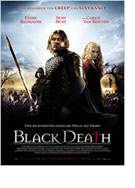

Opening 9 Sep 2010
Directed by:
Christopher Smith
Writing credits:
Dario Poloni
Principal actors:
Sean Bean, Eddie Redmayne, Carice van Houten, Kimberley Nixon, David Warner
The year is 1348 and the local bishop has sent a band of hooligans to find an antidote to the Plague. There are rumours of a village where no one has caught the disease and where the villagers are said to practise witchcraft to keep it away. Well, you would want to know their secret too. Ulric (Sean Bean) is to capture the leader of the village, a man who is a necromancer (a person who communicates with dead people.) Ulricís men have a torture instrument which can bore a hole from a manís bum to his Adamís apple (my words are less flamboyant than those used in the movie) and plan to extract the truth about the necromancerís magic powers if he doesnít do so voluntarily.
Meanwhile, back at the monastery, young Osmund (Eddie Redmayne) has been praying for guidance: should he stay on and become a fully fledged monk or should he follow his heart and be with his sweetheart Averill (Kimberley Nixon)? His prayers are answered when Ulric appears at the monastery and asks for someone to guide his men across the marshes in their search of the village. It just so happens that Osmund grew up near the marshes and Averill has returned home across them so he quickly volunteers his services as a guide.
Averill asked Osmund to meet her at a cross in the marshes at dawn, but when he does so he finds her clothes all covered in blood and assumes that she has died from the Plague. He also finds a roving band of robbers who quickly attack the hooligans. A fierce sword fight with much hacking off of limbs and crushing of heads ensues, ending in the deaths of all the robbers but only one of Ulricís men, hooray.
They continue on their way, find the enchanted village and are welcomed by Hob (Tim Mcinnery) and Langiva (Carice Van Houten). All is not as it seems, and Ulric and his men smell a rat (sorry!) immediately but accept the offers of hospitality in order to investigate further. Soon they are all drugged and find themselves in a water-filled pit where each is to be tortured until everybody has renounced God and Christianity. Langiva is a witch, you see, and Hob is the necromancer.
Plague hasnít reached the village because it is so remote, but the villagers are convinced that the disease was sent by God and they are free from illness because they donít believe in God. Langiva torments Osmund by showing him Averillís corpse and then seeming to raise her from the dead, which severely tests his belief in Christianity. As well it might. Averill has in fact been drugged by Langiva who tricks Osmund into killing his love because she thinks this will shatter his faith in God and he will denounce his faith.
Suffice it to say that by the end of the film poor Ulric comes to a most unfortunate end, Osmund finds himself in safe hands, the necromancer is taken to the bishop and medieval justice has been done, except for Langiva, who seems to live for another day.
Director Christopher Gibb shot his film in Germany but it is set in England. The script is silly and doesnít do justice to what could have been an interesting story. All the horror of the Black Death, the desperate search for answers to explain it and the suffering caused by it are shown, as is the squalor and cruelty of life in the Middle Ages, but they are inadequately explored. The movie quickly develops into an action packed shoot Ďem up with gallons of blood and heaps of horror and is another one to miss. (Jenny Mather)